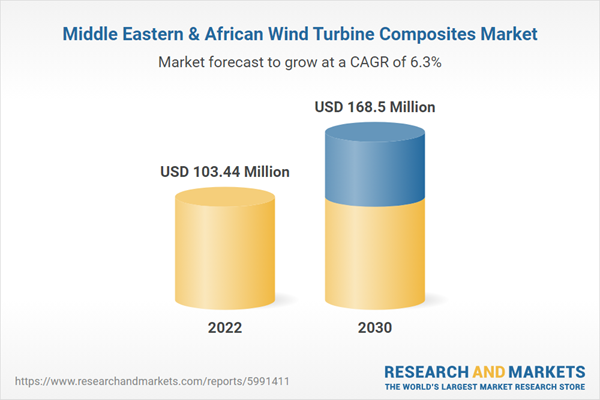Adoption of Natural Fiber Reinforced Polymer (NFRP) Composites Bolsters Middle East & Africa Wind Turbine Composites Market
A wind turbine consists of several parts such as a hub, gearbox, blades, nacelle, and tower, among which wind turbine blades and nacelle are generally composed of composite materials, including glass and carbon fibers. However, these kinds of fibers are often associated with a certain set of limitations, which include their availability, nonbiodegradability, harmful impact on health, and the fabrication cost involved. The use of natural fibers can overcome all these challenges. The growing environmental issues have shifted the attention of researchers and technologists to the use of natural biodegradable materials, which has bolstered the use of natural fiber-reinforced polymer (NFRP) composites in wind turbine manufacturing.Natural fibers are defined as those substances which are made from plants, animals, and minerals with the help of geological processes. Natural fibers obtained from kenaf, bagasse, banana, sisal, flax, hemp, jute, abaca, and bamboo are easily available and need low processing costs. They can be spun together into filaments, threads, or ropes and can be knitted, woven, or matted.
The characteristic features of natural fibers might vary considerably according to their chemical composition and structure; fiber type; and fiber's growing conditions, harvesting time, manufacturing method, treatment, and storage processes. Such reinforced composites form a class of materials that exhibit superior mechanical features as well as potentially replace the conventional material systems in wind turbines.
The NFRP composites possess certain advantages as compared to synthetic fiber-reinforced composites. These benefits include low density, minimal cost, nonabrasive features, biodegradability, and renewable nature. Hence, the rising concern and awareness about the social and environmental impacts of conventional materials are resulting in the shift toward environment-friendly materials by manufacturers of composites, which is expected to fuel the Middle East & Africa wind turbine composites market growth during the forecast period.
Middle East & Africa Wind Turbine Composites Market Overview
The wind turbine composites market in the Middle East & Africa is segmented into Saudi Arabia, South Africa, the UAE, and the Rest of Middle East & Africa. South Africa is a prominent contributor to the market in the region. According to the Global Wind Energy Council, the country installed 515 MW of new wind power capacity in 2020. Senegal ranked second for new capacity established in 2020 by installing 103 MW of wind power capacity, followed by Morocco (92 MW), Jordan (52 MW), Iran (45 MW), and Egypt (13 MW).In 2020, Senegal inaugurated West Africa's first large-scale wind farm, which will supply nearly a sixth of the country's power requirements after reaching full capacity. With this wind farm, the country is expected to derive 30% of its energy from renewable sources. Saudi Arabia is also taking various initiatives to develop its renewable energy sector. This factor favors the growth of the wind turbine composites market in the Middle East & Africa.
Middle East & Africa Wind Turbine Composites Market Revenue and Forecast to 2030 (US$ Million)
Middle East & Africa Wind Turbine Composites Market Segmentation
The Middle East & Africa wind turbine composites market is segmented based on fiber type, resin type, technology, application, and country.Based on fiber type, the Middle East & Africa wind turbine composites market is segmented into carbon fiber composites, glass fiber composites, and others. The glass fiber composites segment held a larger share in 2022.
In terms of resin type, the Middle East & Africa wind turbine composites market is categorized into polyester, epoxy, polyurethane, vinyl ester, and others. The epoxy segment held the largest share in 2022.
Based on technology, the Middle East & Africa wind turbine composites market is segmented into resin infusion, prepreg, lay up, and others. The resin infusion segment held the largest share in 2022.
By application, the Middle East & Africa wind turbine composites market is bifurcated into blades and nacelles. The blades segment held a larger share in 2022.
Based on country, the Middle East & Africa wind turbine composites market is segmented into South Africa, Saudi Arabia, and the Rest of Middle East & Africa. The Rest of Middle East & Africa dominated the Middle East & Africa wind turbine composites market in 2022.
Avient Corp, Covestro AG, Gurit Holding AG, Hexcel Corp, Hexion Inc, SGL Carbon SE, and Toray Industries Inc are some of the leading companies operating in the Middle East & Africa wind turbine composites market.
Reasons to Buy:
- Save and reduce time carrying out entry-level research by identifying the growth, size, leading players, and segments in the Middle East & Africa wind turbine composites market.
- Highlights key business priorities in order to assist companies to realign their business strategies.
- The key findings and recommendations highlight crucial progressive industry trends in the Middle East & Africa wind turbine composites market, thereby allowing players across the value chain to develop effective long-term strategies.
- Develop/modify business expansion plans by using substantial growth offering developed and emerging markets.
- Scrutinize in-depth Middle East & Africa market trends and outlook coupled with the factors driving the wind turbine composites market, as well as those hindering it.
- Enhance the decision-making process by understanding the strategies that underpin commercial interest with respect to client products, segmentation, pricing, and distribution.
Table of Contents
Companies Mentioned
- Avient Corp
- Covestro AG
- Gurit Holding AG
- Hexcel Corp
- Hexion Inc
- SGL Carbon SE
- Toray Industries Inc
Table Information
| Report Attribute | Details |
|---|---|
| No. of Pages | 89 |
| Published | June 2024 |
| Forecast Period | 2022 - 2030 |
| Estimated Market Value ( USD | $ 103.44 Million |
| Forecasted Market Value ( USD | $ 168.5 Million |
| Compound Annual Growth Rate | 6.3% |
| Regions Covered | Africa, Middle East |
| No. of Companies Mentioned | 7 |









